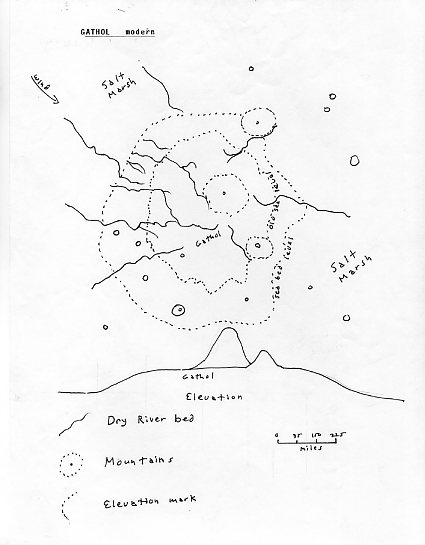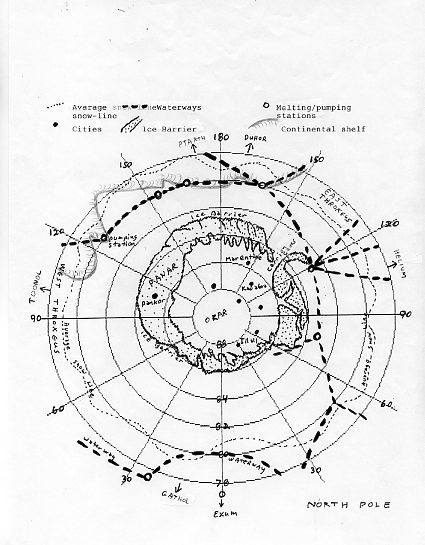

by: Rick Johnson 
PO Box 40451
Tucson, Az.
85717
RikJohnson@juno.com
Back to the Atlas main page.
Back to the Contents page.
Of course, no one likes to have to print up four of the sectionals and try to cut them out and glue them into one map like paper-dolls. Thus this page. These are some of the more well-known, or least-known areas on Barsoom.

Amhor was once an island but as the seas receeded, it became a plateau. Because of her height above the seabed, she is safe from ground attack and fears only air assault for Burroughs mentioned more than once that the red man is a poor climber.
This height, even if only a hundred meters or so, posed problems for the waterways and so radium-powered pumping stations were built to push water up to the plateau.

Very little is known about this place other than it is a desert forest with trees and mosses adapted for a dry climate but not as dry as the low deserts. There are two known cities here, Invak and Onvak, both of whom use invisibility pills to defend their forest and cities against foreign invaders.

Gathol was an island in the Throxus ocean. It had one major mountain upon which the city was placed as a fortress. As the city grew, it crept down the mountain to meet with and absorb the smaller towns on the plateau. Gathol was known for their thoats and gemstone mines.

Today, Gathol is a large mountain city in the middle of a salt marsh, thus to their exports of thoats and gems, they added salt and whatever seafood managed to survive in this marsh which is similar to the Great Salt lake of Utah or the Dead Sea of Jordan. Barsomian life is very adaptable so life will survive given a chance.

The Iss River runs through a number of craters and rift valleys as it cut its way south across half the planet. Some of these craters and valleys filed with water to become lakes, others were shallower and became marshes and still others well-watered forests. Thus the Iss passes through many of these micro-environments where life flourishes.
Pilgrims followed the river to heaven but some would drop out along the way and settle in these micro-environments. The Valley of Dorís Gate (heavenís Gate) is one of these. The Iss flows through a marsh that offers little chance to land so most pilgrims pass through the valley not knowing the wonders that lie beyond the marsh vegetation and monsters. Dorís Gate has two cities, both at odds but rarely at war, knowing that each provides what the other cannot so peace, though strained, exists. The eastern valley is mostly grazing land and is inhabited by Red pilgrims who turned away as the eastern shore is slightly easier to access.
The western valley is more suited to farming and hosts one of the last groups of the Orovar race, hidden away and avoiding contact with their red descendents and dreaming of their lost glories.

Helium boasts the Twin Towers of greater Helium and Lesser Helium, both of which rise a mile into the sky. To the nw is the forest which is one of the last sources of skeel and near the center is the wealth of helium, the famous Helium Iron Mines, the nickel-iron asteroid that formed the crater. Helium has a number of waterways which show her importance to the world but those that stretch se pass through lands claimed by the Tharks and so are poorly maintained and guarded by strong armies.

Because of the fame of Helium, I offer one of the few color maps on this site.

The Koal Forest is the most lush on Barsoom. A lower area along the coast, the River Iss passes through the forest adding precious water to the vegetation. Like all Martian vegetation, the forest is descended from red-algae so everything is red or reddish-yellow with almost no green. Because of the low gravity, there is little need for woody trunks to support strength so most of the Ďtreesí are actually mossy ferns or fern-like mosses though some true trees do exist.
In the nw part is an impact crater that holds water to produce a wet-forest, The rest of Koal ranges between temperate forest and high forest.
Because of the unique variation in environment, creatures that became extinct over the rest of Barsoom manage to survive in the Koal Forest, major among these is the, fortunately rare sith. Resembling a wasp the size of an Earthly bull, this monster can be killed best by piercing its heart with a lance tipped with the sithís own venom.
Koal is the only known city in the forest thought there are probably more, most of whom are subject to Koal.

The lost Sea of Korus is a massive impact crater whose ejecta formed the Otz Mountains. As the Iss cut her way south, she found and filled Korus to create the last remaining surface water of any size.
To the sw lie the only sizeable flat area which became the Valley Dor and home of the Therns.

As the pilgrims traveled south along the Iss seeking Heaven, many who survived the journey turned away at the last moment and sought a precarious living in the Valley of Lost Souls. These unfortunate souls, damned forever for turning aside, own little save what they may create from the rocks of the valley, eating only what they grow or manages to fall into the valley. So destitute are these that both Thern and Black Pirate ignore them.

The Valley Dor is considered to be Heaven by many, if not most of Barsoom. That is until John Carter returned to Barsoom to learn the truth. Note that the distance between where Tars Tarkas entered by the river Iss and the place where he met John Carter again is so vast that it shows his skill to have survived so long.
Or possibly the coast between the delta of the Iss and the place where they met was the only landing spot in the valley for travel along the Iss was facilitated by canoes places long the way by the Therns.
Today the Valley Dor is still inhabited by white apes, plant-men and other monsters thought it is said that the yellow-wigged Therns (to hide their baldness) have given up cannibalism and their own godhood to try to live a more normal life.

Okar and Pankar are two of the hidden nations of Barsoom. Preferring to live in the artic in hothouse cities, the Yellow race of Okar were the first, claiming the lives of any who sought that far north. Escaped slaves, unable to exit the north for the Carrion Caves are the only ground passage, formed the red nation of Pankar.

The Toonol Marsh is the greatest wetland on Barsoom. Watered by the jet stream from the Artolian Hills, the marshes remain wet and feed the Iss. Here are swamp adapted versions of the normal creatures such as the splay-footed banth along with other creatures long dead on the rest of Barsoom.
The Marshes are host to two great powers, the Athiestic Toonoolians in the east and the fanatical Tur-worshippers of Phundahl in the west, a line of forts keeping each at bay from the other.
Here too lives Ras Thavas and scattered about the results of his failed experiments.
It is said that the occasional free city or lost race lives in the Marshes but if so, they remain unknown.
Back to the Atlas main page.
Back to the Contents page.

To contact me or to request topics to be covered, send to RikJohnson@juno.com
by: Rick Johnson 
PO Box 40451
Tucson, Az.
85717
